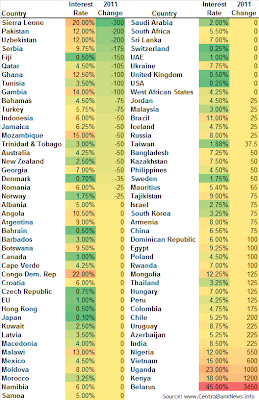This article reviews the monetary policy interest rate activity of the world’s central banks during 2011. The major theme of the year was monetary policy tightening, but the second half of the year featured many banks opting to reverse course or switch to outright net loosening. Indeed of the 87 central banks that Central Bank News monitors, 34 made net increases to their interest rates, while 32 held their rates net unchanged, and 21 made net reductions to their policy interest rates, many of these in the second half of the year (see: Global Interest Rate Movements: Half-Year Review).
Of the central banks that net increased their interest rates, the average increase was 281 basis points (skewed up by Belarus; the average would be 185 excluding Belarus). There were 18 central banks tightening by 100 or more basis points. The outliers were Belarus 3450bps, Kenya 1200bps, and Uganda 1000bps. Of those tightening rates, it was largely emerging and frontier markets, with inflation pressures running high on the back of rising food commodity prices and relatively buoyant economic conditions, particularly in the early part of the year.
There were relatively few central banks cutting interest rates, but of those that did, most made the move in the second half of the year as signs of slowing global growth started to show. However the European sovereign debt crisis was perhaps the most poignant reason for loosening policy settings; with a few central banks opting to take a precautionary or preemptive move e.g. Australia. The average interest rate cut among those to net-loosen monetary policy was 96 basis points.
So while the second half of the year saw increasing loosening of monetary policy, the major theme of the year in monetary policy was tightening. Much of the policy tightening went on in emerging markets where inflation has been pushed above inflation targets due to rising global commodity prices and strong economic growth and activity levels (i.e. both demand pull and cost push). The year also saw some non-conventional monetary policy moves (as noted in: Top 10 Most Extreme Monetary Policy Moves of 2011).
The course of monetary policy in 2012 will be highly dependent on the course of global growth, but especially the resolution or otherwise of the European sovereign debt crisis. Though with signs that inflation is peaking in some of the key emerging markets, and slowing global trade, it is likely that the first half of 2012 will be dominated by monetary policy loosening. At the same time, this could well turn to tightening in the second half; particularly as economies begin stabilize, policy stimulus flows through, and inflationary pressures begin to re-emerge.
Whatever the course of interest rates in 2012, keep checking the website for regular and comprehensive global monetary policy updates.
Source: www.CentralBankNews.info
Article source: http://www.centralbanknews.info/2012/01/global-interest-rate-movements-in-2011.html


